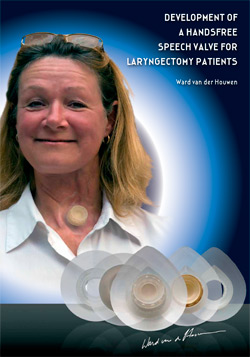Development of a handsfree speech valve for laryngectomy patients
 Without a larynx and thus without vocal cords, it is impossible to speak. Patients, who have had a throat tumor surgically removed, have survived cancer but pay a high price. Apart from their voice, they have lost their sense of smell, as they inhale through an opening at the front of the neck and not through their nose. The inhaled air irritates the airways, as it is cold, dry and unfiltered.
Without a larynx and thus without vocal cords, it is impossible to speak. Patients, who have had a throat tumor surgically removed, have survived cancer but pay a high price. Apart from their voice, they have lost their sense of smell, as they inhale through an opening at the front of the neck and not through their nose. The inhaled air irritates the airways, as it is cold, dry and unfiltered.
There are artificial “noses” and speech valves on the market allowing patients to speak and breathe soundly again, but they are not used very often. We have looked into why not.
The first problem is the application on the skin around the neck opening. The adhesive patches, onto which the valves and filters are fixed, do not fit well. The shape of the neck opening was measured in 191 patients. They proved not to be flat, (as the patches assume), but funnel shaped. Thus, new, contoured, patches were designed.
The second problem is the speech valve. Commonly used speech valves are closed with a finger: the patient does not have both hands free and points to the neck opening. By contrast, the most commonly used handsfree speech valve is expensive and complicated. A new handsfree speech valve has been designed. Remarkable is the design’s simplicity: the use of silicone rubber reduced the number of parts from 14 to 1!
Patients are very enthusiastic about both products. The company Servona is collaborating with us toward production of the speech valve.
More information about the first valve prototype iValve v1 and the second valve prototype iValve v2

